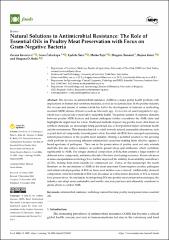Natural Solutions to Antimicrobial Resistance: The Role of Essential Oils in Poultry Meat Preservation with Focus on Gram-Negative Bacteria

View/
Date
2024Author
Kovačević, Zorana
Čabarkapa, Ivana
Šarić, Ljubiša
Pajić, Marko
Tomanić, Dragana
Kokić, Bojana
Božić, Dragana
Metadata
Show full item recordAbstract
The increase in antimicrobial resistance (AMR) is a major global health problem with
implications on human and veterinary medicine, as well as food production. In the poultry industry,
the overuse and misuse of antimicrobials has led to the development of resistant or multi-drug
resistant (MDR) strains of bacteria such as Salmonella spp., Escherichia coli and Campylobacter spp.,
which pose a serious risk to meat safety and public health. The genetic transfer of resistance elements
between poultry MDR bacteria and human pathogens further exacerbates the AMR crisis and
highlights the urgent need for action. Traditional methods of preserving poultry meat, often based on
synthetic chemicals, are increasingly being questioned due to their potential impact on human health
and the environment. This situation has led to a shift towards natural, sustainable alternatives, such
as plant-derived compounds, for meat preservation. Essential oils (EOs) have emerged as promising
natural preservatives in the poultry meat industry offering a potential solution to the growing
AMR problem by possessing inherent antimicrobial properties making them effective against a
broad spectrum of pathogens. Their use in the preservation of poultry meat not only extends
shelf life, but also reduces reliance on synthetic preservatives and antibiotics, which contribute
significantly to AMR. The unique chemical composition of EOs, that contains a large number of
different active compounds, minimizes the risk of bacteria developing resistance. Recent advances
in nano-encapsulation technology have further improved the stability, bioavailability and efficacy
of EOs, making them more suitable for commercial use. Hence, in this manuscript, the recent
literature on the mechanisms of AMR in the most important Gram-negative poultry pathogens
and antimicrobial properties of EOs on these meat isolates was reviewed. Additionally, chemical
composition, extraction methods of EOs were discussed, as well as future directions of EOs as natural
food preservatives. In conclusion, by integrating EOs into poultry meat preservation strategies, the
industry can adopt more sustainable and health-conscious practices and ultimately contribute to
global efforts to combat AMR.
